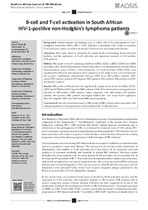B-cell and T-cell activation in South African HIV-1-positive non-Hodgkin’s lymphoma patients

View/
Date
2018Author
Flepisi, Brian T.
Bouic, Patrick
Sissolak, Gerhard
Rosenkranz, Bernd
Metadata
Show full item recordAbstract
BACKGROUND: Altered immune mechanisms play a critical role in the pathogenesis of non-
Hodgkin’s lymphoma (NHL). HIV-1 (HIV) infection is associated with a state of excessive
T-cell activation, which can lead to increased T-cell turnover and lymph node fibrosis.
Objectives: This study aimed to determine the serum levels of circulating B-cell activation
markers, and the expression of T-cell activation and regulatory markers in HIV-positive
NHL patients.
METHOD: The serum levels of circulating soluble(s) sCD20, sCD23, sCD27, sCD30 and sCD44
molecules, all of which are biomarkers of B-cell activation, were determined by enzyme-linked
immunosorbent assays (ELISA), while biomarkers of T-cell activation (CD8+CD38+) and
regulation (FoxP3) were determined by flow cytometry in 141 subjects who were divided into
five groups: Combination antiretroviral therapy (ART)-naïve HIV-positive patients; ARTtreated
HIV-positive patients; HIV-negative NHL patients; HIV-positive NHL patients on ART;
and healthy controls.
RESULTS: HIV-positive NHL patients had significantly higher serum levels of sCD20, sCD23,
sCD30 and sCD44 than HIV-negative NHL patients, while all five biomarkers were significantly
elevated in HIV-positive NHL patients when compared with ART-treated HIV-positive
patients. HIV-positive NHL patients had higher CD8+CD38+ and lower FoxP3 expression
than HIV-negative NHL and ART-treated HIV-positive patients.
CONCLUSION: B-cell activation is increased in HIV-positive NHL patients and is associated with
reduced regulatory T-cell populations and increased CD8+ T-cell activation.
